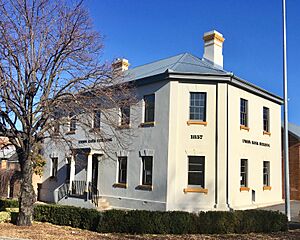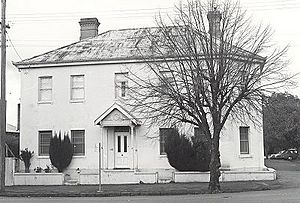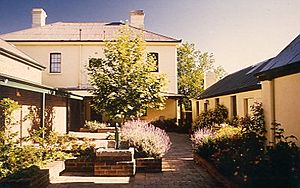Union Bank of Australia building, Orange facts for kids
Quick facts for kids Union Bank of Australia building |
|
|---|---|

Former Union Bank of Australia
|
|
| Location | 84 Byng Street, Orange, City of Orange, New South Wales, Australia |
| Owner | The Trustee for Union Bank Property Trust |
| Official name: Union Bank of Australia (former); Weymouth House; Hesley Gallery | |
| Type | State heritage (built) |
| Designated | 2 April 1999 |
| Reference no. | 230 |
| Type | Bank |
| Category | Commercial |
| Lua error in Module:Location_map at line 420: attempt to index field 'wikibase' (a nil value). | |
The Union Bank of Australia building is a very old and important building in Orange, New South Wales. It has been used for many different things over the years. First, it was a bank, then a police station, and even a school! Today, it holds offices and a restaurant. This building is also known as Union Bank of Australia (former), Weymouth House and Hesley Gallery. It is protected because of its history and special design. The building is owned by The Trustee for Union Bank Property Trust. It was added to the New South Wales State Heritage Register on 2 April 1999.
Contents
History of the Building
The Union Bank of Australia first opened in Orange in 1857. They started in a temporary spot. In 1858, they moved into this very building. It was the first bank ever in Orange!
In April 1862, another bank, the Commercial Banking Company of Sydney, took over the Union Bank's business. After this, the building was bought and used as a police station. New police buildings were built nearby in Byng Street around 1874-1875.
Later, a man named Mr. T. H. Richards opened a school here. He called it Weymouth House. In 1893, Mr. Richards moved his school. The building then became a girls' school called Dombrane College.
Around 1911 or 1912, the school closed. The building then became a boarding house. Miss Hawke and her mother ran it. After being a boarding house, it was used as residential flats.
Protecting the Building
In February 1980, the National Trust of Australia (NSW) warned that the old Union Bank building might be torn down. To stop this, a special order was placed on the building. This order meant it could not be demolished.
The owners wanted to pull it down, but the Heritage Council stepped in. They worked with the Orange Council and the owners. On April 18, 1980, a temporary order was put in place. This gave them time to find a good new use for the building.
In August 1980, the Department of Public Works looked at the property. They said the building was important for its history. They also noted its value to the street's look. They suggested it could be used for offices or homes and businesses.
In 1981, the property was sold. The new owners received money to help restore the building. On February 11, 1983, a permanent order was placed on the property. This meant it would be protected forever. The building was officially added to the State Heritage Register on April 2, 1999.
What the Building Looks Like
The main part of the building has two floors. It is made of brick and has an iron roof. The outside walls are covered in a smooth finish. At the back, there is a newer, single-story brick room. This room was likely added when the building was a school. It might have been a classroom or a hall.
A wooden porch was also added to the main entrance. This porch is in the Federation style. Other small buildings are at the back. These include a separate kitchen house and a stables block. The stables still have their original horse "boxes" and wooden floors. A garage was added to the stables later.
Inside the Building
The bank building itself has a simple and plain Victorian design. The front of the building is made more interesting by special decorations. These include fancy lintels (pieces above windows), keystones (wedge-shaped stones in arches), and sills (bottom parts of windows).
Inside, the building is also very simple. It does not have the fancy decorations often seen in big buildings from that time. The original doors, door frames, and skirtings (boards along the bottom of walls) are still there. The fireplace surrounds and the main staircase also remain. All these parts have simple, basic designs.
Changes Over Time
The building has changed quite a bit over the years:
- 1858: The main two-story building was built.
- 1880s: The single-story building at the back was added.
- 1981: The Heritage Council approved plans to change and restore the buildings.
- 1983: The Heritage Council approved using the ground floor for a restaurant.
- 1985: The Heritage Council approved dividing the property into three separate parts. They also approved changing how the property was used.
- 1988: The Heritage Council approved adding a new fire escape, firehose reel, and emergency lighting.
- 1992: The Heritage Council approved replacing the portico (a covered entrance) and making changes inside.
Why This Building is Important
The former Union Bank building is very important for its history. It opened in 1858 and was the first bank in Orange. This shows its significance in the early development of the town.
The building also has a special look. It has a simple but strong Victorian style. The decorative parts around the windows make it interesting. Because it is on a corner, it adds a lot to the look of the street.
The Orange branch of the Union Bank of Australia was added to the New South Wales State Heritage Register on April 2, 1999. This means it meets certain important standards.
Historical Importance
The building is important because it shows the history of New South Wales. It was the first bank in Orange, which is a big part of the town's story.
Design and Style
The building is also important for its design. It has a simple Victorian style. The decorative parts like the lintels and keystones make it special. Its location on a corner makes it a strong and positive part of the street's appearance.
See also
- Australian non-residential architectural styles





